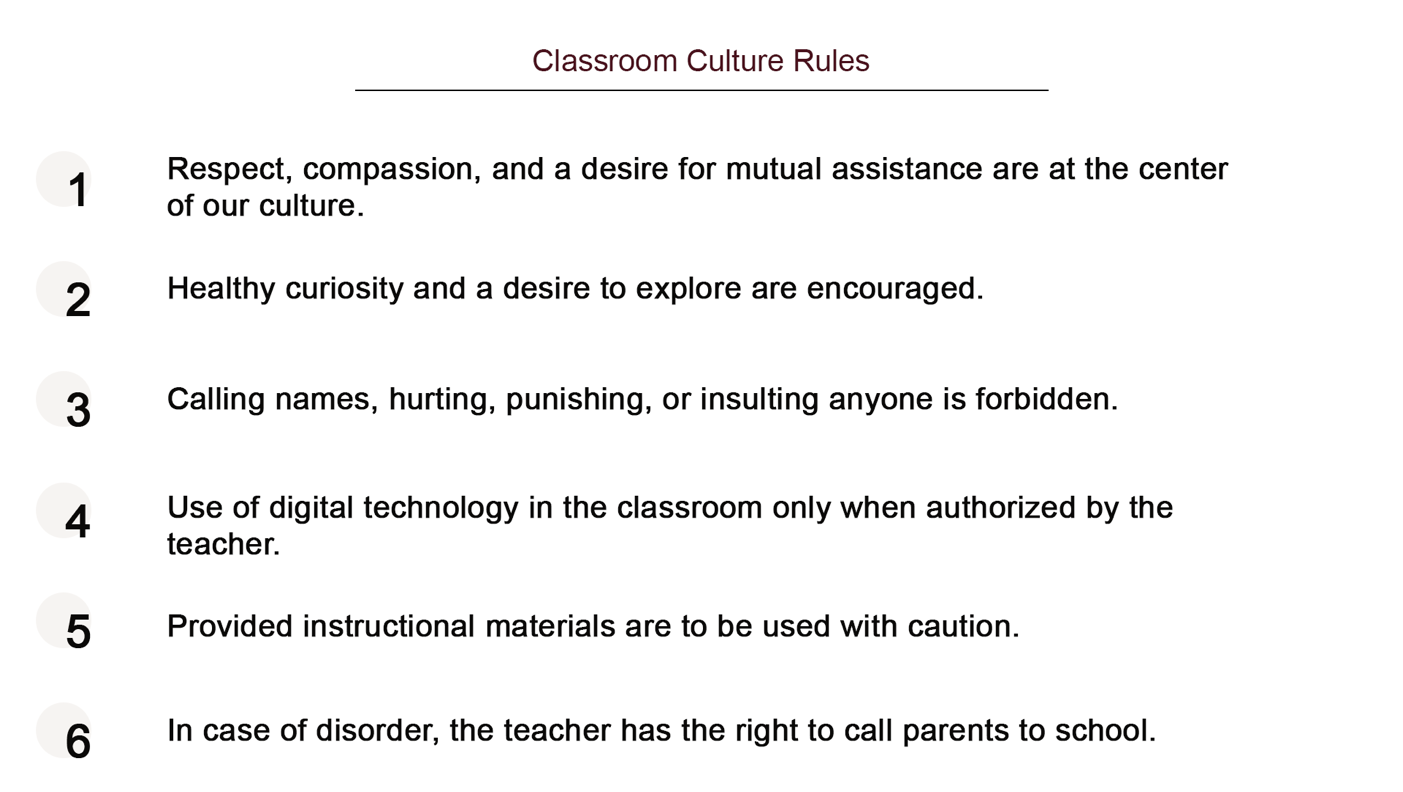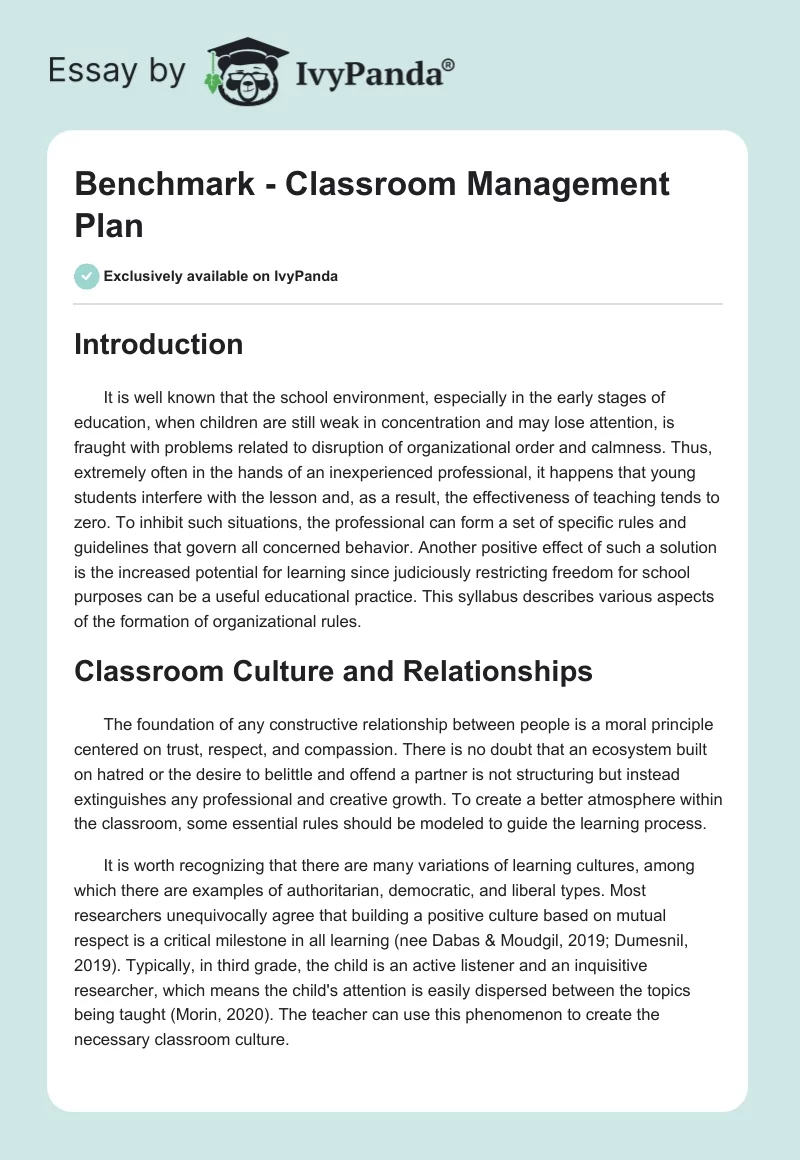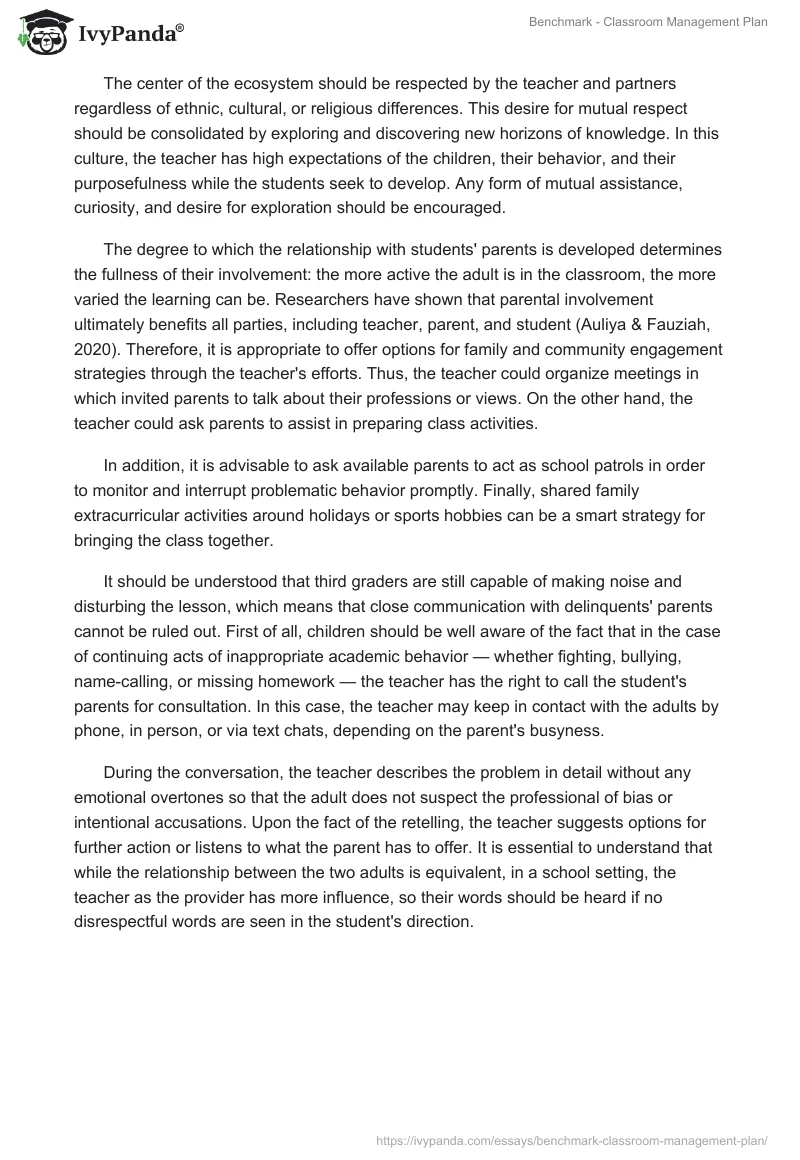Introduction
It is well known that the school environment, especially in the early stages of education, when children are still weak in concentration and may lose attention, is fraught with problems related to disruption of organizational order and calmness. Thus, extremely often in the hands of an inexperienced professional, it happens that young students interfere with the lesson and, as a result, the effectiveness of teaching tends to zero. To inhibit such situations, the professional can form a set of specific rules and guidelines that govern all concerned behavior. Another positive effect of such a solution is the increased potential for learning since judiciously restricting freedom for school purposes can be a useful educational practice. This syllabus describes various aspects of the formation of organizational rules.
Classroom Culture and Relationships
The foundation of any constructive relationship between people is a moral principle centered on trust, respect, and compassion. There is no doubt that an ecosystem built on hatred or the desire to belittle and offend a partner is not structuring but instead extinguishes any professional and creative growth. To create a better atmosphere within the classroom, some essential rules should be modeled to guide the learning process.
It is worth recognizing that there are many variations of learning cultures, among which there are examples of authoritarian, democratic, and liberal types. Most researchers unequivocally agree that building a positive culture based on mutual respect is a critical milestone in all learning (nee Dabas & Moudgil, 2019; Dumesnil, 2019). Typically, in third grade, the child is an active listener and an inquisitive researcher, which means the child’s attention is easily dispersed between the topics being taught (Morin, 2020). The teacher can use this phenomenon to create the necessary classroom culture.
The center of the ecosystem should be respected by the teacher and partners regardless of ethnic, cultural, or religious differences. This desire for mutual respect should be consolidated by exploring and discovering new horizons of knowledge. In this culture, the teacher has high expectations of the children, their behavior, and their purposefulness while the students seek to develop. Any form of mutual assistance, curiosity, and desire for exploration should be encouraged.
The degree to which the relationship with students’ parents is developed determines the fullness of their involvement: the more active the adult is in the classroom, the more varied the learning can be. Researchers have shown that parental involvement ultimately benefits all parties, including teacher, parent, and student (Auliya & Fauziah, 2020). Therefore, it is appropriate to offer options for family and community engagement strategies through the teacher’s efforts. Thus, the teacher could organize meetings in which invited parents to talk about their professions or views. On the other hand, the teacher could ask parents to assist in preparing class activities.
In addition, it is advisable to ask available parents to act as school patrols in order to monitor and interrupt problematic behavior promptly. Finally, shared family extracurricular activities around holidays or sports hobbies can be a smart strategy for bringing the class together.
It should be understood that third graders are still capable of making noise and disturbing the lesson, which means that close communication with delinquents’ parents cannot be ruled out. First of all, children should be well aware of the fact that in the case of continuing acts of inappropriate academic behavior — whether fighting, bullying, name-calling, or missing homework — the teacher has the right to call the student’s parents for consultation. In this case, the teacher may keep in contact with the adults by phone, in person, or via text chats, depending on the parent’s busyness.
During the conversation, the teacher describes the problem in detail without any emotional overtones so that the adult does not suspect the professional of bias or intentional accusations. Upon the fact of the retelling, the teacher suggests options for further action or listens to what the parent has to offer. It is essential to understand that while the relationship between the two adults is equivalent, in a school setting, the teacher as the provider has more influence, so their words should be heard if no disrespectful words are seen in the student’s direction.
Classroom Rules/Expectations and Procedures

To inform students about the new rules pictured above, it is appropriate to put together a workshop where the teacher will explain the innovations. For the most effective transfer, especially in a classroom setting with children with disabilities, the teacher should take care to differentiate the content: tell the rules by ear, provide pictures on the board, and hand out printed materials. Once the list of six rules has been voiced, the teacher invites students to discuss the importance and value of creating the regulations: this should be a constructive discussion. During the discussion, it is likely that students will want to supplement the rules with new guidelines, so the teacher should build an open dialogue.
The rules imposed are made binding, and if they are repeatedly violated, the teacher calls the parents for a consultation. As a result of this conversation, it becomes clear whether the student can continue in that class. While as extensive as possible for different areas of classroom practice, the suggested six rules are a short squeeze that is sufficient for a third grader to understand. This includes the use of digital technology: because it is a valuable resource that a student can ruin, the rules prescribe careful and careful use for academic purposes only (“Digital technology,” 2020). The guidelines and order can be monitored in three different ways: the teacher, a student on duty, or an invited parent.
Student Behavior
Encouraging acts of good behavior, preventing, and managing lousy behavior should be based only on a respectful and strict approach that excludes various emotional and conflict situations. By virtue of their age and experience, the professional should not go into an argument with students but must be able to manage it. So, in case of non-observance of the rules, the teacher gives a warning to the pupil — publicly or personally — and points out the possibility of calling the parents next time. If the pupil continues to show deviant behavior, in this case, a meeting with the pupil’s parents or guardians is necessary to decide on the pupil’s future school fate.
In contrast, if students diligently follow the six precepts, it means that they should be encouraged. First of all, there should be a framework for the reporting period: for example, if a student has behaved well for a month and has not broken a rule, in which case he deserves a reward. As a reward, the teacher could offer the student the opportunity to skip one homework assignment. On the other hand, for students who perform best, an opportunity can be created to go with the teacher to an extracurricular activity, whether it be a trip to the movies, theater, or a picnic.
References
Auliya, A. F. S., & Fauziah, P. (2020). Advices for involving parents in children’s learning activities from school to home. Jurnal Obsesi: Jurnal Pendidikan Anak Usia Dini, 5(2), 1073-1082.
Digital technology safe use guide for schools. (2020). Ministry of Education. Web.
Dumesnil, K. (2019). Creating a culture of learning. eLearning Industry. Web.
Morin, A. (2020). Skills kids need going into third grade. Understood. Web.
nee Dabas, M. W., & Moudgil, D. (2019). Challenging stereotypical notions of discipline in elementary schools: Building a positive classroom environment. Indian Journal of School Health & Wellbeing, 5(3), 1-10.


